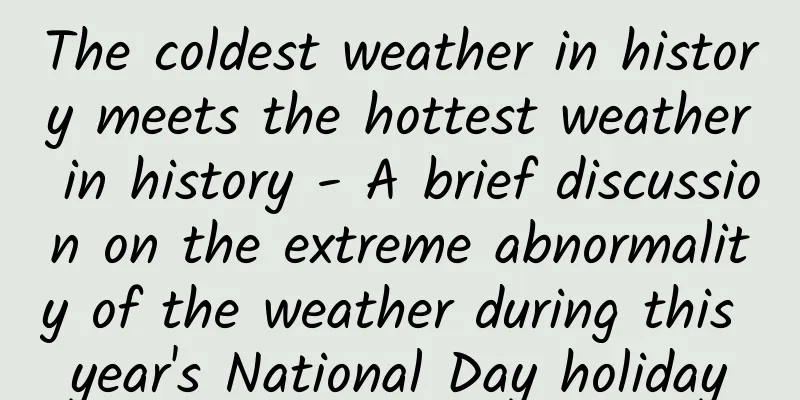The coldest weather in history meets the hottest weather in history - A brief discussion on the extreme abnormality of the weather during this year's National Day holiday

|
1. The meaning of extreme and abnormal In order to better understand the weather during this year's National Day holiday, it is necessary to briefly explore the meaning of extreme and abnormal. In my opinion, extreme weather and abnormal weather have both similar and different meanings. The similarity is that they are both uncommon weather, which can be reflected by the degree of deviation from the usual/ordinary (average) situation. The difference is that when we mention extreme, we usually associate it with the extreme intensity of the weather, while abnormal weather expresses more rarity, which is not necessarily very strong. For example, the heavy rainstorms in Henan in 2021 were both extreme in intensity and extremely rare; but the rainfall in Shanxi during the National Day holiday in 2021 was not extreme or rare in intensity in summer, but extremely rare in autumn. In order to evaluate weather and climate events, some academics define the strongest minority (or 5%, or 1%, etc.) as extreme, and this extremeness must also include abnormality. For example, the intensity of high and low temperatures, the intensity of rainfall, etc. all have annual variations, and the strongest minority among them are naturally extremely abnormal. However, if we do not examine the entire year, but rather the same period of history, that is, what ordinary people call "this time of year in previous years", the abnormality may not be extremely strong. For example, the classic saying of "snow in June" has nothing to do with the intensity of snowfall, but it is obviously extremely abnormal, and it is not wrong to understand it as extreme weather. 2. Extremely warm weather before the long holiday In fact, I personally used to be very disgusted with using words like extreme and abnormal to describe strong weather processes. But in recent years, I have to do this frequently because historical data comparisons are ironclad facts that are irrefutable. For example, during the first three days of the National Day holiday, a total of 610 national stations (there are more than 2,400 national stations across the country) broke the historical record for the highest temperature in early October. Actual maximum temperatures across the country from October 1 to 3, 2022 (Central Meteorological Observatory, red circles represent breaking historical extreme values for the same period) In the south, many stations experienced three consecutive breaks, such as "yesterday broke history, today broke yesterday, and tomorrow breaks today". For example, Lu'an, Anhui, broke three consecutive records and reached 40.7℃ on the 3rd, the highest level in the same period in history. Its intensity is not inferior to the extreme high temperature in summer, and it increased the previous historical record by 4.1℃. Top 10 extreme values list (Central Meteorological Observatory, the same below) Although some of these 610 record-breaking stations did not break the record consecutively and may have only broken it once, they still occupied the top three because they were broken on October 1, such as Jiangxia, Hubei. In fact, within the red circled areas in the south of the first picture above, record-breaking behavior is seamless. Specifically, Hubei, Jiangsu, Anhui, Jiangxi, Hunan and other provinces have almost all stations breaking records, and southern Henan and Zhejiang and Fujian have also broken records seamlessly except for the coastal areas. Most of them are in the top three or three of the top five, and the worst ones are all in the top 10. At the same time, the south was experiencing extremely high temperatures, and the north was also experiencing record-breaking conditions, such as Erenhot in Inner Mongolia. Generally, we call temperatures higher than the average for the same period of normal years warmer, and those that are much higher are called significantly warmer or abnormally warmer. Obviously, the fact that the above record-breaking days are not only significantly warmer, but also the warmest in history, so the term "extremely warm" is well deserved. It is well deserved to be the hottest National Day in history (referring to the history of meteorological observation)! 2. Extremely rare cooling in history It is against such an extremely warm background that this round of strong cold air swept from the north to the south, which resulted in two characteristics of this round of cooling weather. First, the temperature drop is so great that it far exceeds any standard that defines the intensity of cold air reaching a cold wave. The temperature drop index for the Central Meteorological Observatory's cold wave blue warning is a drop of 8°C in more than four provinces, and the highest cold wave orange is a drop of 12°C in more than four provinces. This temperature drop refers to the drop in the average temperature or the lowest temperature. The temperature drop this time is rare in history. I haven't checked it in detail, but it is likely to be the largest temperature drop in history. The figure below shows the total temperature drop since September 30. The highest color code in the figure is -18℃ black and red. In fact, the temperature dropped by more than 20℃ in a large area, and a considerable part exceeded 25℃. In other words, the actual temperature drop far exceeded the upper limit we considered when designing this figure, so the figure below shows a large area of single black and red. The largest temperature drop since September 30 Of course, the temperature drop in the above figure is roughly equivalent to the drop in the maximum temperature, which is larger than the drop in the average temperature or the minimum temperature. Since the lowest temperature in most parts of the south will occur tomorrow (6) morning, there is no final data yet, but I estimate that it should exceed 15℃ in a large area, which is also far beyond the cold wave warning standard. The following figure is an animation of the 24-hour temperature change at 14:00 each day. It is worth mentioning that the North China Plain had already experienced a drop in temperature due to rain before the cold wave arrived, and the temperature drop caused by the cold wave was not strong, so it appeared to be jumping. In terms of the daily temperature drop (24 hours), the largest national station was the above-mentioned Lu'an, Anhui. The temperature at 15:00 p.m. on the 4th dropped by 27.3℃ compared to that at 15:00 p.m. on the 3rd, and the encrypted regional automatic station observed a drop of 31.1℃ (Sanguaidian, Hanbaidu, Yu'an, Anhui). The figure below shows a 3-hour animation, which can more clearly show the cooling process. 3-hour animation of the maximum temperature drop from 14:00 on September 30 to 14:00 on October 5 The second characteristic is that although the temperature has dropped dramatically, the previous high temperature has caused the family foundation to be too rich, and a lean camel is bigger than a horse, so the lowest temperature after the temperature drop is still far from one of the indicators of the cold wave issued by the Central Meteorological Observatory (the lowest temperature in the Jianghuai region reached 4°C) (the lowest temperature in the Jianghuai region on the 4th was around 10°C). Although the lowest temperatures on the 5th and 6th may drop by another 1-3°C, they still cannot reach the indicators. The lowest temperature from 08:00 on October 4 to 08:00 on October 5, 2022 All of this was predicted with certainty in advance, so after comprehensive consideration on the morning of October 2, I issued a cold wave warning. But this exception was also in compliance with the law, because in the current warning issuance regulations of the Central Meteorological Observatory, Article 24 stipulates that forecasters can issue warnings at their discretion when certain weather indicators do not meet the warning standards. 3. Extremely cold weather during the late holiday period - at least during the day As of now (afternoon of the 5th), the main cooling process of this cold wave has basically ended, and only a small part of the southern region will experience a slight drop in temperature tomorrow and the day after tomorrow. Judging from the known minimum temperature on the 4th, 9 national stations in the northern region have broken the historical minimum extreme value in early October. For example, the lowest temperature of 4.8℃ in Dengfeng, Henan, broke the 41-year-old record. Linxi County, Inner Mongolia, even broke the 67-year-old record of -6.8℃ on October 8, 1955 with a temperature of -7.4℃. The lowest temperature in the south still has room to drop slightly, and is expected to be at its lowest level on the night of the 5th or the 6th. It is hard to say whether it can break the historical extreme value for the same period, and the final conclusion will be made the day after tomorrow. Some stations should break the record, but most stations may not reach it. Since the daily minimum temperature record was not common, it might be a stretch to say that it was the coldest National Day in history. However, if we look at the daily maximum temperature, it is almost certain that a large area will break the historical record for the lowest daily maximum temperature in October. The record for the lowest daily maximum temperature is a bit confusing, so just think of it as "the coldest daytime". At present, 32 national stations in northern China have broken the record of the lowest daily maximum temperature in October. Let's take a representative example. The Lushun Station in Liaoning Province broke the record of 12℃ on October 10, 2017 with a temperature of 11.5℃. The Huai River region, located at the junction of the north and south, is most likely to break the record for the lowest maximum temperature. At 15:00 this afternoon, the temperature in these areas was generally between 7 and 11 degrees Celsius. Surface temperature at 15:00 on October 5, 2022 The historical minimum daily maximum temperatures in early October in these areas are mostly between 11 and 15 degrees Celsius. Let's take two familiar stations as representatives. At present, this area is in cloudy and rainy weather with little sunshine, and it will remain so tomorrow and the day after tomorrow. In this case, it is difficult for the maximum temperature to rise. According to the previous temperature comparison, the record will be easily broken. So we can basically say: The National Day holiday in 2022 is both the hottest and the coldest in history! This freak of weather allowed us to witness history again. ---End of full text--- Welcome to follow the official account: Taotao Fengyun |
<<: Is releasing fireflies romantic or cruel?
>>: What fruit juice contains up to 80% sugar?
Recommend
The money-burning model of video websites "joining hands" with film and television companies is unsustainable
Recently, as Huace Film & TV suspended tradin...
What regulations should be followed when adding keywords to Baidu search promotion?
What are the specifications for adding keywords? ...
Millions of IPs Create Science and Technology Talents to Strengthen the Country丨LiuGong: Extending Human Power with Smart Green Machinery
In recent years, China's construction machine...
Still worried about AirPods being lost? A brooch can help
Apple's first truly wireless earphone product ...
Wei Jianli of Ingenic Group: Challenges facing IoT chips
The Internet of Things is considered to be the th...
If I give you 1 million for promotion, how would you spend it? 4 major platform optimization methods, which can be copied and executed!
The original intention of writing this article is ...
Timely warning and comprehensive deployment in many places to actively respond to blizzards and cold waves
Affected by the cold wave, the temperature in the...
Tencent Advertising's guide to attracting customers!
1. Industry Background Preview 1. Development tre...
Can locust plagues be avoided by pinching the locusts' "nose"?
Produced by: Science Popularization China Author:...
Aren’t non-woven bags used for takeout considered eco-friendly bags? They are also “plastic bags”?
Now, if you buy vegetables online, you can get a ...
Who is healthier, someone who sweats when it gets hot or someone who doesn’t sweat even if it’s too hot?
【Written at the end】 If you suffer from heart dis...
Are peanut milk and fruit-flavored milk substitutes for cow's milk? Just a few words difference, but big nutritional difference
Milk is rich in nutrients Not only rich in protei...
BOE's LC smart light curtain empowers Zeekr 009 to create a milestone in intelligent dimming for passenger cars
On April 19, 2024, Zeekr 009 Guanghui was officia...
Breaking gravity, humans will conquer space walking, are you ready?
How long does it take to orbit the moon? It may b...
Will being alone for a long time affect your social skills? See how many of these behaviors you meet
During the epidemic, many people have been quaran...









